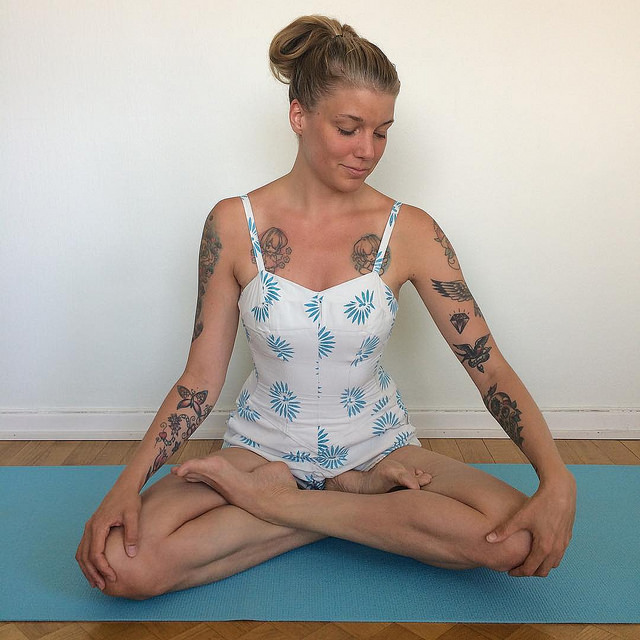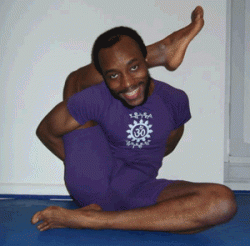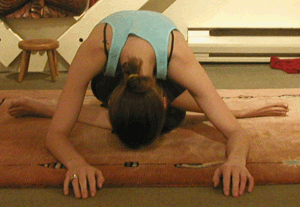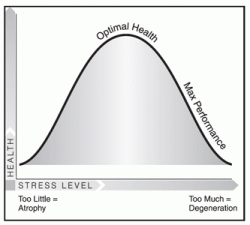
Editor’s Note: We lovingly assume zero liability for the choices you make on or off the mat. Be kind to your body!
The desire for yin yoga classes seems to be growing louder than the groans of students coming out of the poses.
But, while more and more people resonate with this wonderful style of practice, there have also been cautions—and some are quite vocal.
Are the critiques valid, or are there some flaws in the logic being presented?
Here are a few of the concerns I’ve heard voiced:
- Yin yoga is dangerous for students who are pregnant, hypermobile (hyperflexible), have osteoporosis, etc.
- There is no proof yin yoga works; it does not increase flexibility;
- It doesn’t build strength or stability in the joints;
- It destabilizes the joints;
- I know someone who was hurt doing yin yoga.
This is not an exhaustive list, but it is a good place to start.
What is Yin Yoga?
Since I wish to respond to criticisms of yin yoga, the onus is on me to define what I mean by the term, which admittedly may not be what others mean. Unfortunately, there are many misunderstandings of what yin yoga is, and how it is best taught. This has arisen because there is no standardized form of yin yoga. No one owns it. No one created it. Anyone is free to call what they teach “yin yoga.” My definition of yin yoga is the particular style of yoga I learned from Paul Grilley and Sarah Powers, who have been teaching it since the 1990s. They coined this practice “yin yoga” to differentiate what they were teaching from Paulie Zink’s Taoist yoga. (For a history of yin yoga, see Who owns Yin Yoga.) This is the practice I mean when I use the term yin yoga and it is the style I have described in my books.
The Intentions of Yin Yoga
When the criticism is leveled at yin yoga that it is inappropriate for some students, we have to first acknowledge that this is true to the extent that no single form of yoga is appropriate for all people. The reality of human variation is so vast that there is no medical intervention or therapy that works for everybody (even aspirin is harmful to some people). This applies to yin yoga, but also to all forms of yoga: Ashtanga and Bikram‘s can be dangerous to some people, as can restorative practices. Life is inherently dangerous: people have died just getting out of bed in the morning—but this does not mean that people should not get out of bed. It means that everything can be a problem for some people, and that includes yin yoga.
Having acknowledged that yin yoga may not be appropriate for some, I do not mean it is inappropriate, as a rule, for people with hypermobility, pregnant women, students with osteoporosis, osteoarthritis, bad backs, or a host of other ailments. These conditions by themselves do not preclude the practice. I have written elsewhere on why hypermobile students may benefit from adopting a yin yoga practice and I won’t repeat all those points again here, but I will point out one very important fact: the repertoire of yin yoga postures are nowhere near as deep or intense as other yoga styles and do not take a hypermobile student anywhere close to the limits of her range of movement. There is little chance of these students going too far in a yin yoga class, because yin yoga does not offer postures that take the body as far as a hypermobile student could go.
In yin yoga, there are no advanced poses like Urdva Dhanurasana (wheel pose) or Eka pada sirsasana (foot behind the head pose).
Hypermobile students should not be afraid of yin yoga making them more flexible.

This is not a Yin Yoga pose
Setting up the straw man, “Yin yoga stretches ligaments.”
When a teacher criticizes yin yoga, they are often attacking a straw man. A straw man is a logical fallacy, which presents a proposition that is not the reality and then that proposition is critiqued, not the reality.
Take for example the statement: “Yin yoga stretches the connective tissues and that is a bad thing to do.” The fear of “stretching connective tissues” is a straw man: yin yoga does not intend to stretch connective tissues, ligaments, or joint capsules. If this were the intent, I would agree with the criticism. Yin yoga intends to stress connective tissues, and that does include joint capsules, fascia, ligaments, tendons and even the muscles.
Stress is not the same as stretch!
Let’s define a few terms to make this clear: “Stress” is the force we apply to our tissues, while “stretch” is the resulting elongation, if any, that results from the force. Lots of tissues can stretch: our muscles, tendons, fascia, ligaments, and joint capsules can all elongate—some only a little, others a lot. But for many yoga students, the intention is not to stretch but to strengthen: they need more stability in their joints, not less. To build this stability they still need to stress the tissues, but not to the point of stretching. It may even be more appropriate for yoga teachers, especially yin yoga teachers, to use the verb “stress” when they habitually use the term “stretch.”
Every tissue in our body needs exercise to remain or regain health. In our yang forms of exercise, we engage our muscles to reduce the dynamic, potentially destabilizing stress on the joints. But, if we are not stressing the joints in our active yoga practice, when can we safely stress these tissues? During yin yoga! During the long held, static stress on our connective tissue, biochemical changes occur at a cellular level: the fibroblasts, chondrocytes and osteoblasts that rebuild our fascia, ligaments, cartilage and bones respond to the mechanical strains that they experience. The fear expressed by those criticizing yin yoga arises due to this misunderstanding: we are not trying to stretch connective tissues. We are trying to stress them.
For some students, even a little stress can be too much.
For some students, the stress of a yin yoga posture on the connective tissues may be too much. They may already have a weakened joint, ligament or fascial connection, and it would be easy for them to go too far now. These students need to pay close attention to the signals the body is giving them, to discover how much stress their body can tolerate and for how long. But this warning applies regardless of what style of yoga they choose to practice: they need to practice with both attention and intention. But this does not necessarily preclude a yin yoga practice for these students. There are many benefits available through yin yoga: developing mindfulness, relaxing the nervous system (turning off the sympathetic response), enhancing energy flow, etc.

This is a yin yoga pose
Even students with damaged joints or weak bones need to stress these tissues! All tissues need stress, but when the tissues are damaged, it is easy to go too far. This doesn’t mean no stress at all is the healthiest option: the optimal level of stress is to be sought. Perhaps this is the time for a restorative yoga class, rather than a yin yoga class. Remember, yin yoga is not for everyone, but this certainly does not mean that it is not for anyone, or many “ones.” Even some students with problematic joints may find yin yoga beneficial, as long as they don’t try to do too much.
Pregnant Yin
Just as hypermobile students can benefit from a yin yoga practice, so can pregnant students. Again, the intention is not to enhance flexibility but to optimize health. A pregnant yoga student attending a yin yoga class is advised not to seek greater range of motion (ROM); whatever ROM she had before becoming pregnant should be her limit now; but she can benefit energetically, mentally and even physiologically from a yin yoga practice. Many yin yoga teachers are also prenatal teachers who have borne babies and found yin yoga helpful. The concerns raised against yin yoga from a prenatal perspective are all focused on going too far physically. That need not be an intention or a concern if the student pays attention and accepts her previous range of motion as her current limit.
Time is more important than intensity.
The Goldilocks’ position: Not too much, and not too little!

The Goldilocks’ position is in the middle of the curve
One of the reasons people misunderstand yin yoga is because they believe the practice focuses on taking joints to their ultimate range of motion: this is not what is suggested. In yin yoga we try to find the Goldilocks’ position—not too much, and not too little. We do need to feel something, stress is necessary, but it is not necessary to go to a maximum limit. We come to an edge where we feel a stress, then we wait. We linger. We marinate in the juiciness of the posture. We do not seek the maximum edge.
Time is more important than intensity. Studies by Helen Langevin and her coworkers have shown that sometimes we need to let a stress soak in for 30 minutes before “fibroblasts change shape in response to sustained stretching.” [1] While we do not hold a single posture for 30 minutes in yin yoga, we may stress a targeted area for that long, through multiple postures. [2] Thomas Myers, whom I will quote again later, also says sustained stretches are required to allow muscles to relax so that the fascia starts to stretch and release.
Since we are not seeking maximum intensity and we do not take joints to their extreme ranges of motion, there is no reason for hypermobile or pregnant students to avoid yin yoga out of fear of becoming more flexible.
Yin yoga and osteoporosis
Yoga teacher Margaret Martin created a blog and video describing her first experience with yin yoga and how frightened she was for the students in that class. Her fear: osteoporosis. Margaret is very experienced in teaching students with osteoporosis. In her view, these students must not allow their spines to flex at all: all flexion must come from the hips.
This is an over-reaction and an over-simplification. Outside the yoga studio, people with osteoporosis flex their spine through simple daily living. Leaning over the bathroom sink to brush teeth, bending over to tie shoes, reaching for the kale in the fridge, or for the salt on the table all cause some flexion in the spine. Yes, they can go too far: but, again, to never stress the spine will lead to atrophy of the tissues you are trying to protect. (There a term for this: disuse osteoporosis[3]!) For people with mild osteoporosis some flexion is necessary to maintain back health; for people with severe osteoporosis, caution is reasonable.
These students should tell their yoga teachers before class starts about this condition, or seek a restorative class! Students: do not abdicate your health responsibility to a teacher. It is your spine, not theirs. Learn your limits and respect them.
Blaming the practice instead of the teacher.
In fairness to Margaret, she does state in her blog, “So if you chose to do a yin class, you really have to be meticulous about your alignment. You have to take it upon yourself to ensure that your alignment is correct.” But then she goes on to say, “Otherwise I suggest you look for a different type of yoga.” I would point out that it is not yin yoga that is inherently dangerous, but how the teacher leads the class and how much responsibility the student gives up to the teacher. Someone with severe osteoporosis is well-advised to learn what will be appropriate for her, regardless of what style of yoga she is doing or what the teacher is asking her to do. It is not yin yoga per se that Margaret found dangerous but how it was presented. I am sure she would have had the same comments if she saw flexion of the spine occurring in any yoga class. Regardless, it is also not reasonable to blame the teacher in every situation.
Unreasonable expectations of a yoga teacher.
It is unreasonable to expect a yoga teacher to know about all possible pathologies or injuries that a human body is subject to. Some yoga teachers are medical doctors and physical therapists, but even they don’t know everything, and even if they did, there is not enough time in one class to run through an exhaustive list of every possible malady that students might have and what to do about them. We can try to focus on the important ones, but which ones are those?
One teacher well educated in osteoporosis will talk about how to be careful of postures that might cause harm in students suffering porous bones. Another teacher knowledgeable about osteoarthritis will spend time offering contraindications for problem joints. Another teacher will caution students who are pregnant, or suffer high blood pressure, or diabetes, or…the list can go on and on. It is unreasonable to expect that any teacher can be knowledgeable in all areas or can offer contraindications for all conditions. The failure to do so is not a judgment of the teacher’s qualities or personality; it is just a fact of life. We cannot protect every student from every problem.
What a teacher can do, however, which is far more reasonable and powerful than reciting a cascade of contraindications, is teach the student how to be her own doctor, therapist, and yoga teacher. Teachers can give cues and guidance to the student on how to listen to her own body, to determine which sensations are acceptable or to be avoided, to notice how her body responds to her practice, to take reasonability for her own life.
Where is the proof that yin yoga works?
While scientific studies have been conducted over the years on the benefits of yoga, there are not many, and many are not conclusive. This is not just a problem with yin yoga! It is hard to find clinical studies that verify many of yoga’s health claims. This is slowly changing[4], but I am aware of no studies specifically about yin yoga. It just hasn’t been studied yet (although, I am aware of a few pending studies, and look forward to their conclusions.)
The absence of proof is not proof of absence.
Just because yin yoga has not been proven to work does not mean that it does not work. I could share with you many anecdotes from people who told me that yin yoga has helped them. However, it is not possible for me to say what it was about yin yoga that was efficacious: was it the physical stress, the calming environment, the mindfulness practice, getting out of the house, the presence of a community? We don’t know why, but we do know people felt better after yin yoga.
Certainly mindfulness, which there is a lot of opportunity to practice in a yin yoga class, has been studied and found helpful to many.[5] Long held static stresses have also been found to be beneficial in pain management and reorganizes the connective tissue (again, see Helen Langevin’s work.[6]) We can verify that many parts of yin yoga work therapeutically, and we can report on anecdotes that show it to be effective, but we cannot point to any specific studies, not yet anyway, that prove it works. But this is not proof that yin yoga is not beneficial.
Other practices do not include long-held stretches, so why does yin yoga?
I have heard this claim or ones similar: “There are no sustained stretches in the dance world”. Or, I am told, in Tai Chi or Ki Gong or other Eastern practices. It is a strange critique because it is a form of “guilt-by-dissociation.” It is like saying, “If no one else is doing something, then it must be wrong.” Imagine if this attitude was applied to the first antibiotics: “No one else is using penicillin, therefore it must not work: don’t take penicillin!” Clearly this is flawed reasoning, but this comment is problematic for another reason: long-held stretches have been used for centuries! Yin yoga is not new, nor is sustained stretching unique to yin yoga. Dancers have used this practice, despite what some ex-dancer yoga teachers may claim.[7] For a long time gymnasts have also employed static stretches. Yin-like postures have been described in both ancient texts and in B.K.S. Iyengar’s Light on Yoga (written in the 1960s). This critique is problematic and wrong.
“A friend of mine got hurt while doing yin yoga.”
I am truly sorry to hear of anyone being injured while doing any form of yoga, but the fault is not always the practice. There is a logical flaw called the last straw fallacy which highlights the inappropriateness of assigning blame to an event simply because it was the closest event in time to the occurrence of a problem. Recall that it is the “last straw” that is blamed for breaking the proverbial camel’s back, which ignores the great weight of all the other straws already loaded onto the poor camel. The same situation arises in yoga; a student may have a dangerously weakened joint from years of repetitive stress from sports, from work, from lifestyle…and yet, when she comes to a yoga class and does the one posture which is the last straw, she will blame that posture for the pain and problem. She may also extrapolate and blame the style of yoga, the teacher and the studio. This can happen in any style of yoga. Pigeon is a great posture to blame for hurting knees, but often the problem arises because of the predisposition to injury already existed, developed over years, but was ignored.
If a predisposition for an injury or fragility in a joint exists, then there is a real danger of a precipitating event occurring while doing yin yoga, or another yoga style. In these cases, the injury is unfortunate, but blaming any particular style of yoga for causing the injury is inappropriate. A more useful investigation should be to look into what caused the predisposition, how to avoid making matters worse, and how to recover health. It may likely be true that people with certain joint problems should avoid a yin yoga practice: remember, yin yoga is not for everybody.
Science has shown that yin yoga does not increase range of motion.
I have to boldly refute this claim: Science has not shown that yin yoga does not increase ROM. One reason I can state this so boldly is the fact that no one has yet studied yin yoga! The other reason is that I have seen it increase my ROM and that of my students. It is one thing to say we don’t know how yin yoga increases ROM, but to state it doesn’t increase ROM is to deny evidence that is very plain to see. The genesis of this criticism of yin yoga seems to come from recent studies that have looked at short-held, cyclical stresses and the effect they have on the range of motion of a muscle.[8]
These studies used 20-second to one-minute applications of stress, and concluded that increased range of motion are due to nervous system responses, not because of a permanent lengthening of the muscle. There are many problems with this conclusion and these studies: first—they were not studying yoga; they were studying stretching. Yoga is far more than just stretching: it is breath work, mindfulness, stress and recovery, practiced over years. Secondly, these studies were not using yin-like stresses, which are held much longer. Finally, these studies do not take into account the reality of many yoga students’ experience. Yoga does make us more flexible. To deny this obvious fact because some studies don’t know why it happens is ludicrous. Let’s make the science fit the facts, not ignore the facts because our theories are, so far, inadequate to explain them.
I was sent an email with a critique of yin yoga, claiming that fascia experts have found “passive stretching doesn’t actually change anything.” To rebut that statement, I will return to Thomas Myers, who ironically was cited as one of the fascia experts. He recently said,
“…generally, the sustained stretches of yoga where you hold a posture for several minutes…give the muscles a chance to calm down. The muscles have to relax first, and then the fascia starts to stretch and release. And that can facilitate the kind of repatterning that leads to lasting release of chronic holdings and, in many cases, a profound change of mind and body…
General exercise won’t [work]. They will not change the pattern of the fascia. You need long, slow stretches…One of the wonderful things about yoga is that because of the sustained stretch held in many yoga poses, you actually do change the connective tissue. So you change the pattern of that fascia and thus you can get down to the chronic tension patterns lodged in the tissues. [Emphasis added]”
It is a challenge for anatomists, clinicians and scientist to explain the reality that so many students have experienced: yin yoga has increased their range of motion. The question to be considered is not “does it?” but “how does it do it? [9]”
Summary
Most of the criticisms about yin yoga misrepresent what it is and how it is practiced. The criticisms are aimed at a straw man caricature, not the actual practice of yin yoga. Yin yoga does not seek maximum ranges of motion, it does not try to stretch our joints, and it does not destabilize the joints. It does seek to stress the connective tissues, which is not the same as stretching them. This stress can strengthen the connective tissues around a joint to make the joint stronger.
Yin yoga can be a safe, healing practice for most students, even pregnant women or hypermobile people, as long as they practice with intention and attention. Like any yoga practice, there are a few people who probably would be better advised to do a different practice—not because yin yoga is inherently dangerous, but because every body has unique needs and what works well for one person may not work for the next.
Notes:
1) “Ongoing studies in my lab are addressing why the fibroblasts change shape in response to sustained stretching. So far we have found that the changes are associated with a large-scale relaxation of the connective tissue. We also saw that the fibroblasts initiated a specific Rho-dependent cytoskeletal reorganization that was required for the tissue to fully relax. Rho is an intracellular signaling molecule known to play a role in cell motility and the remodeling of cell-surface proteins that connect the fibroblast to its surrounding matrix. The molecule’s involvement in fibroblast shape change suggested that the cells are able to reduce the tissue tension by adjusting how strongly and where they are gripping the surrounding connective tissue or muscle. In addition, we found that the shape change is also associated with a sustained release of ATP from the fibroblast. Within the cell, ATP acts as fuel, but outside of the membrane, ATP can function as a signaling molecule. Extracellular ATP can be converted to other purines such as adenosine, which can act as a local analgesic, thus providing a possible cellular and physiological mechanism to explain the pain relief experienced by some acupuncture patients.” From The Science of Stretch, Helene M. Langevin, May 1, 2013, The Scientist.
2) We may perform in sequence Butterfly, Half-butterfly, Saddle and Caterpillar, which together will stress the fascia along the back of the body for 30 minutes or more.
3) See NASA’s explanation of disuse osteoporosis.
4) See 50 scientific studies of yoga.
5) See “What are the benefits of mindfulness” at www.apa.org.
6) Check this article for a representative example.
7) Not only have many dancers used long held stresses to increase their range of motion, there are styles of dance which require long held stillness as part of the dance (for example, Butoh dance.)
8) “Holding stretches for 20 to 30 seconds is a good standard because most of the stress relaxation in passive stretches occurs in the first 20 seconds.” See The Biomechanics of Stretching by Duane Knudson in the Journal of Exercise Science & Physiotherapy, Vol. 2: 3-12, 2006
9) For more on how yin yoga may work, see my article A Scientific Basis for Yin Yoga.
Author: Bernie Clark
Images: Helen Alfvegren at Flickr / www.yinyoga.com (via Bernie Clark)
Editors: Renée Picard: Travis May











Read 2 comments and reply